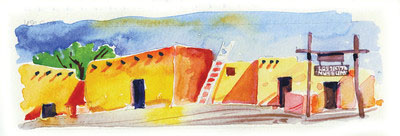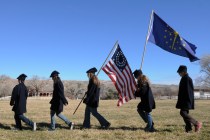Lost City Museum features artifacts from area’s past
Occupying a little bluff outside Overton, the Lost City Museum, Pueblo Grande de Nevada, interprets thousands of years of cultural heritage along the Muddy River in northeastern Clark County. Inside, the facility protects a treasury of artifacts spanning 10,000 years of human activity in the river valley. Outside, it re-creates the kind of multi-unit village developed by farmers of prehistory populating areas with water resources in the desert Southwest.
The museum lies about a hour's drive from Las Vegas. To reach it, drive north on Interstate 15 about 55 miles to exit 93. Turn on Highway 169, which runs south through the small agricultural towns of Logandale and Overton, both dating from Mormon settlement more than 100 years ago. Watch for the museum sign at the southern end of Overton about 12 miles from the I-15 exit.
A short side road takes you to the front of the museum, part of the Division of Museums and History, an agency of Nevada's Department of Cultural Affairs. Now nearly 75 years old, the museum's original adobe building forms part of the current facility's exhibit space, vastly improved and expanded over the years. The reconstructed pueblo with its below-ground-level kiva lies behind the museum building. Drive past the bus parking in front of the museum to reach the main parking lot. It sits adjacent to a lovely shaded area with picnic tables connected to the museum by walkways through plantings of desert vegetation.
Lost City Museum remains open daily from 8:30 a.m. to 4:30 p.m., except on Thanksgiving, Christmas and New Year's Day. Admission costs $3 for adults aged 18 years and $2 for seniors over 65. Children and museum organization members pay no fee.
On one day a year during the museum's annual holiday open house, visitors pay no admission fee. Themed as a "Southwest Celebration," this year's open house falls on Dec. 6. Visitors strolling through exhibits during the open house enjoy refreshments, music by The Zephyr Consort and an exhibit by local artist Georgine Morelli, on hand to sign purchases from 11 a.m. to noon. Raffle ticket holders learn who wins at a 2 p.m. drawing.
During the open house, visitors perusing the nicely stocked museum store get a head start on holiday gift lists and a 15 percent discount. Lost City Museum association members get a total discount of 30 percent. The gift shop features books on Nevada, Native Americans and natural history. It stocks toys, educational materials, maps, posters, souvenirs and jewelry, among many possibilities of gift-giving.
Constructed on the site of an archaeological dig in 1935 by Civilian Conservation Corps workers, the adobe and its additions house artifacts from several digs from privately assembled collections. With Boulder Dam (later Hoover Dam) soon to be completed and the future filling of Lake Mead behind the dam, the pace of archaeological work was feverish as many ancient pueblo sites soon would be under water.
The museum's artifacts represent just a fraction of the materials unearthed along 30 miles of the river valley in many ruins where thousands of people once lived and farmed. Although the bulk of cultural evidence gathered lies catalogued elsewhere, the museum displays enough artifacts to outline regional history.
First visited thousands of years ago by nomadic hunters and gatherers who left few signs of their passing, the native people later began to raise patches of beans, corn, squash and cotton along the river to augment hunting and seasonal harvesting. As dependence upon crops increased, they began to construct single-level dwellings of several small rooms. They also developed simple irrigation systems, better baskets for gathering and improved pots for storage.
They became part of a trading network that extended into south Mexico and Central America and west to the Pacific Ocean. They exploited local deposits of salt and gemstones such as turquoise for use in trading for items they did not produce themselves. Before disappearing for reasons not completely understood, they became the westernmost outpost of the far-flung Anasazi culture extending from western Colorado to eastern Nevada.
Margo Bartlett Pesek's column appears on Sundays.






















